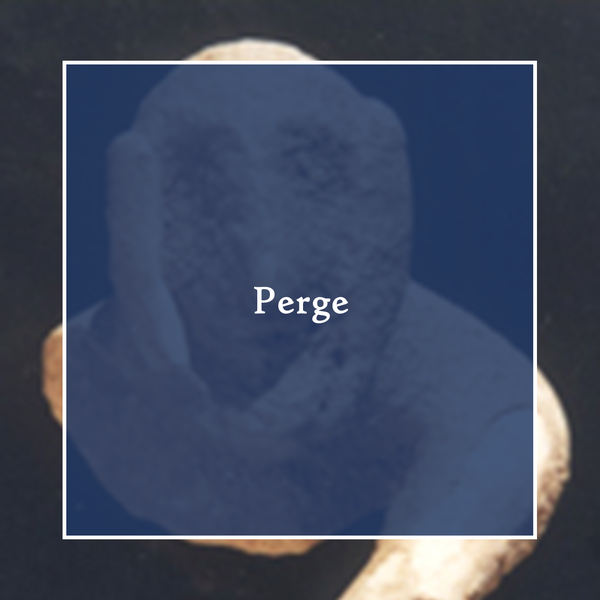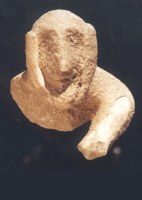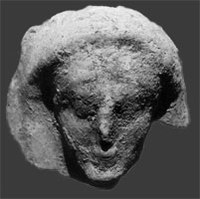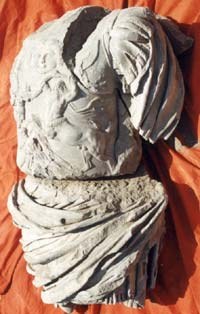The excavation at Perge
 |
The friendly invitation of H. Abbasoglu to participate in the excavations of the late Hellenistic-Roman city of Perge, which he has directed since 1988, led to the joint project of the Universities of Istanbul and Giessen to search for the historically transmitted older phases of settlement in 1993.
Gießen 2001, Wolfram Martini |
An Acropolis?
In view of the large area of the mound of about 400,000 square metres, surveys and soundings were chosen as the most suitable prospection methods for an initial overview.
 |
 |
Left: Fragment of a charioteer, terracotta, 6th century BC, Inv. K105.97
Right: Early Classical female head (protome), terracotta, c. 480/70 BC, Inv. K40.95.2
The structural remains found during the five-week campaigns in Perge, which have been carried out every year since 1999 as part of the DFG priority programme "Ways and Forms of Acculturation in the Eastern Mediterranean", document an elaborate fortification and dense urban development of the larger part of the plateau, which, according to the individual finds so far, lasted from the Geometric to the Middle Byzantine period. In addition, pottery, small implements made of flint and obsidian and burials attest to the presence of people on the mesa since the Late Neolithic or the Early Chalcolithic.
The preliminary overall plan is characterised by large buildings of Classical to Early Byzantine date, the partially sounded road system and a complex fortification especially on the southern slope as well as to a lesser extent on the western side. The northern part of the mesa was not settled, and necropolises spread out on it, as on the slopes to the north, west and southwest.
The main access to the city on the mountain was not the later "city gate" towards the late Hellenistic-Roman city, where, in addition to the excavation of an insula with five residential houses, the late Hellenistic city gate and the city wall were investigated by H. Abbasoglu from 1988 to 1998, but the 22 m wide paved road from the east, the starting point of which was presumably the harbour at the Kestros, which in antiquity led directly east of Perge past to the Pamphylian Sea 12 km away. This 480 m long plateia, initially 22 m, later 17 m wide, crosses the massive fortification of the southern slope to the entrance level of the mesa and branches out in three directions behind the acropolis: To the east, a narrow paved road ascends to the sanctuary where a remnant of inscriptions to Diana Pergaea and inscriptions of priestesses of Artemis of Perge have been found.
To the north, stairs lead to the so-called eastern quarter with dense residential development in an orthogonal street system since archaic times and topographically adapted streets to the so-called eastern hill with three representative residential complexes since Classical times, which presumably served as residences for the local elite. The main road, 11 m wide, runs west for 90 m, past natural and artificial cult caves that once held water, onto the actual plateau of the mesa and passes a Hellenistic peristyle measuring a good 40x40 m.
The discovery of the torso of an Augustan armoured statue, together with the elaborate design of the building, suggests a representative function (state market).

Armoured torso, Inv. K 19.95
It is no coincidence that the core of the Early Iron Age settlement lies in the large hollow between the east and west mounds. Apparently, the prehistoric settlement, indicated by three children's graves, already unfolded in this area. While the few Hittite and Mycenaean sherds cannot be assigned any building remains so far, the oldest remains of the almost orthogonally laid out residential buildings are dated by Cypriot imported pottery to the late 9th century. Rhodian relief amphorae mark the next main phase of construction and document strong Greek influence from the early 7th century BC onwards, which dominates from the 5th century BC onwards and manifests itself in area 1 in the ashlar work of the large banqueting room. While to the south and west the archaic structures were built over in Hellenistic and Imperial times, the banqueting building, the 'cult grotto' and the small sanctuary remained accessible until the Late Imperial period and underline the sacred character of this area.
Pottery and terracotta figurines illustrate the mixture of very different cultural influences. In addition to the dominant Cypro-geometric pottery, Central Anatolian pottery is also found around the 8th century BC; in the 7th century BC, Aegean and Hittite pottery is also found.
Despite the dominance of Greek forms from the Early Classical period onwards, which is expressed in Greek pottery and votives, and which can be related to the Battle of Eurymedon and a possible Attic cleruchy in Perge on the basis of a destruction horizon in area 1 around 470 BC, the known inscription of the early 4th century BC leaves no room for doubt. In view of the known inscription of the early 4th century BC for Vanassa Preia or a vessel fragment of the 5th century BC with sidetic characters, a strong local component remains, which also characterises the peculiar sacred building on the western hill.
The new archaeological evidence does not yet unequivocally confirm Otten's thesis of the existence of Perge in Hittite times and certainly not the ancient tradition of the foundation of Perge and other Pamphylian cities by Greeks involved in the Trojan War; it does, however, show that after Hittite and Mycenaean contacts, an urban settlement with a strong Cypriot character can be observed from the 9th/8th century BC at the latest. It shows, however, that after Hittite and Mycenaean contacts, an urban settlement with a strong Cypriot character can be observed at the latest since the 9th/8th century BC, which in the course of the 8th century BC receives a further cultural component through Central Anatolian pottery.
In the early 7th century BC, the pottery attests to close contacts with Rhodes, and a little later, Aegean import and influence generally increased. In addition, the terracotta figurines as well as the pottery continue to show evidence of Cypriot and, in isolated cases, Late Hittite forms.
This complex mixture of influences from the surrounding advanced civilisations is characteristic of the early phase of the Pamphylian culture, whose genesis is the result of a complex process of acculturation.
The most important goals of future research on the acropolis of Perge are therefore:
1. to search intensively for evidence of Hittite and Mycenaean contacts by means of limited excavation measures in the "early" areas localised by the sondages, in order to verify Otten's thesis and
2. to investigate the question of whether the ancient founding myth might reflect an earlier Greek presence, e.g. in Tarsos, or at least trade relations.
3. to come closer to clarifying questions about the development and character of the urban structure and the fortifications, but also the question of the localisation of the Artemis sanctuary on the Acropolis, by means of selective excavation measures.
4. to shed light on the acculturation processes relevant to the genesis of Pamphylian culture by analysing the great variety of imported and local pottery of the 12th-6th centuries BC, but also the terracotta figurines and the architecture.
